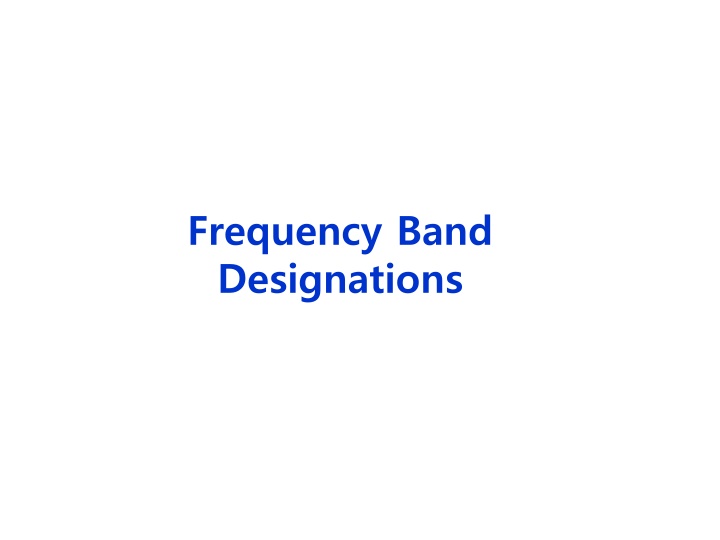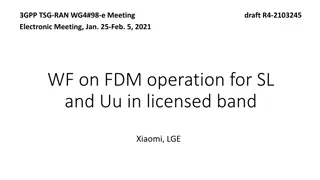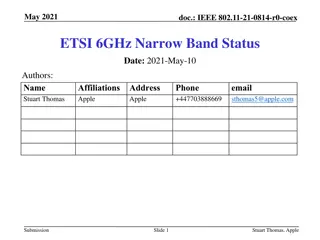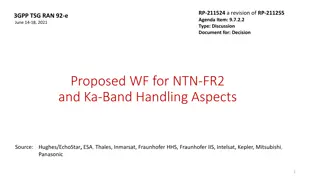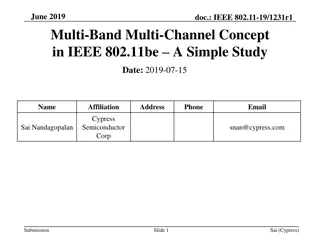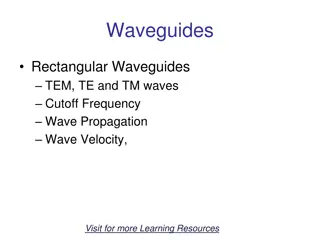Frequency Band Designations Overview
This overview covers various frequency band designations including ITU bands, ECM bands, EU/NATO radio bands, IEEE radio bands, and Waveguide frequency bands. It provides a detailed breakdown of the frequency ranges assigned to each designation, offering valuable insights into the allocation of radio frequencies across different bands.
Download Presentation

Please find below an Image/Link to download the presentation.
The content on the website is provided AS IS for your information and personal use only. It may not be sold, licensed, or shared on other websites without obtaining consent from the author.If you encounter any issues during the download, it is possible that the publisher has removed the file from their server.
You are allowed to download the files provided on this website for personal or commercial use, subject to the condition that they are used lawfully. All files are the property of their respective owners.
The content on the website is provided AS IS for your information and personal use only. It may not be sold, licensed, or shared on other websites without obtaining consent from the author.
E N D
Presentation Transcript
Frequency Band Designations
1. ITU bands 2. ECM bands 3. EU/NATO radio bands alternative 4. IEEE radio bands 5. Waveguide frequency bands
1. ITU (International Radio Union) bands 1 (ELF) 3-30 Hz 2 (SLF) 30-300 Hz 3 (ULF) 0.3-3 kHz 4 (VLF) 3-30 kHz 6 (LF) 30-300 kHz 7 (MF) 0.3-3 MHz 8 (HF) 3-30 MHz 9 (VHF) 30-300 MHz 10 (UHF) 0.3-3 GHz 11 (SHF) 3-30 GHz 12 (EHF) 30-300 GHz 13 (THF) 0.3-3 THz
2. ECM bands (EU/NATO/US) A 0 250 MHz B 250-500 MHz C 0.5-1 GHz D 1-2 GHz E 2-3 GHz F 3-4 GHz G 4-6 GHz H 6-8 GHz I 9-10 GHz J 10-20 GHz K 20-40 GHz L 40-60 GHz M 60-100 GHz
3. EU/NATO radio bands alternative I 100-150 MHz G 150-225 MHz P 225-400 MHz L 0.39-1.55 GHz S 1.55-3.90 GHz C 3.9-6.2 GHz X 6.2-10.9 GHz K 10.9-36.0 GHz Ku 10.9-20 GHz Ka 20-36 GHz Q 36-46 GHz V 46-56 GHz W 56-100 GHz
4. IEEE radio bands HF 3-30 MHz VHF 30-300 MHz UHF 0.3-3 GHz L 1-2 GHz S 2-4 GHz C 4-8 GHz X 8-12 GHz Ku 12-18 GHz K 18-27 GHz Ka 27-40 GHz V 40-75 GHz W 75-110 GHz mm 30-300 GHz
5. Waveguide frequency bands R 1.70-2.60 GHz D 2.20-3.30 GHz S 2.60-3.95 GHz E 3.30-4.90 GHz G 3.95-5.85 GHz F 4.90-7.05 GHz C 5.85-8.20 GHz H 7.05-10.10 GHz X 8.2-12.4 GHz Ku 12.4-18.0 GHz K 15.0-26.5 GHz Ka 26.5-40.0 GHz Q 33-50 GHz U 40-60 GHz V 40-75 GHz W 75-110 GHz F 90-140 GHz D 110-170 GHz G 140-220 GHz Y 325-500 GHz = 2 a b c = = 2 , a f c c c 1.25 1.9 f f f c c
